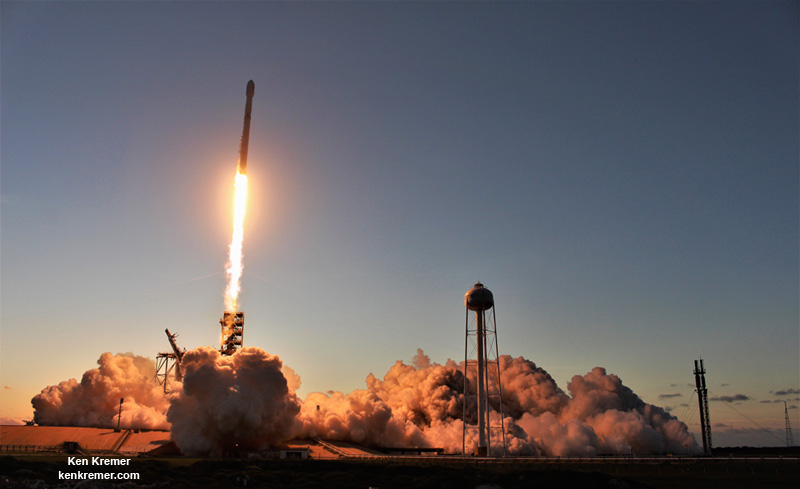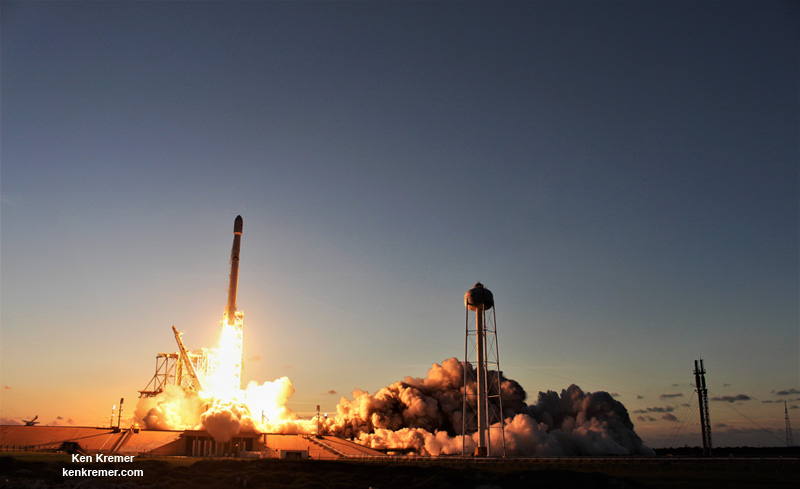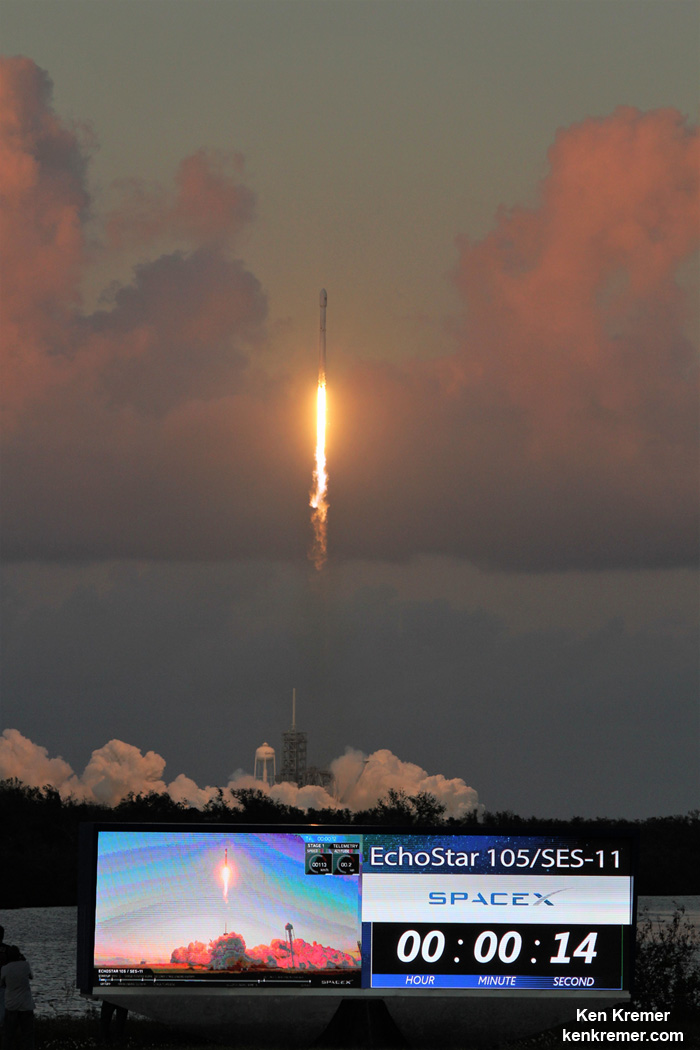
SpaceX Falcon 9 recycled rocket lifts off at sunset at 6:53 PM EDT on 11 Oct 2017 carrying SES-11/EchoStar 105 HDTV commercial comsat to geosynchronous transfer orbit from Launch Complex 39A at NASA's Kennedy Space Center, FL- as seen from the pad perimeter. Credit: Ken Kremer/Kenkremer.com
KENNEDY SPACE CENTER, FL - Elon Musk's extraordinary vision of an era when re-flown rockets are offered as a 'routine service' rather than the exception is a 'major sea change getting closer' to fruition with each passing day thanks to SpaceX, said SES CTO Martin Halliwell in an exclusive interview with Universe Today, following the stunning sunset blastoff of the SES-11 UHDTV commercial satellite on another 'flight-proven' Falcon 9 booster that also re-landed - thus completing another remarkable round of rocket recovery and recycling or 'launch, land and relaunch!'
"As I've said before, I think in a couple years time you won't even consider whether it's a preflown rocket or a new rocket or a second time rocket," SES Chief Technology Officer Martin Halliwell told Universe Today in a one-on-one post launch interview.
"It will just be a flight and you will buy a service to get to orbit – and that will be that!"
"It's a major sea change," Halliwell explained. "That's absolutely true."
"We're getting closer to that every day. It's exactly where we are going. There is no doubt about it."
The private SES-11/EchoStar 105 communications satellite mission soared to space with an on time liftoff of the recycled SpaceX Falcon 9 first stage at dinnertime Wednesday Oct. 11 at 6:53 p.m. EDT from seaside Launch Complex 39A at NASA's Kennedy Space Center in Florida.

SpaceX Falcon 9 recycled rocket lifts off at sunset at 6:53 PM EDT on 11 Oct 2017 carrying SES-11/EchoStar 105 HDTV commercial comsat to geosynchronous transfer orbit from Launch Complex 39A at NASA's Kennedy Space Center, FL- as seen from the pad perimeter. Credit: Ken Kremer/Kenkremer.com
"The launch was fantastic," Halliwell gushed. "Everything went perfectly. The countdown went perfectly, no hiccups, no drama, nothing whatsoever. So we were good to go!"
Plus its saving SES "months of time" and thereby "tens of millions of dollars of real money" to fly with a used booster rather than having their expensive satellite sit and languish uselessly on the ground.
SES-11 is primarily intended to significantly upgrade SES capabilities to transmit Ultra High Definition (UHD) TV signals or 4 K vs. standard HDTV – thereby pulling in more revenue streams.
SES made rocket history jointly with SpaceX earlier this year when they became the first company ever to agree to fly a payload on a recycled liquid fueled rocket that SpaceX's billionaire CEO Elon Musk dubs 'flight-proven'.
And Halliwell, as SES Chief Technology Officer, was instrumental in partnering with SpaceX CEO Musk to take a big leap make that happen.
The maiden 'used' Falcon 9 lifted off successfully with the SES-10 satellite and delivered the comsat to geostationary orbit on March 30, 2017 - in a monumental space achievement.

SpaceX Falcon 9 recycled rocket lifts off at sunset at 6:53 PM EDT on 11 Oct 2017 carrying SES-11/EchoStar 105 HDTV commercial comsat to geosynchronous transfer orbit from Launch Complex 39A at NASA's Kennedy Space Center, FL- as seen from the pad perimeter. Credit: Ken Kremer/Kenkremer.com
"This was our second reflown mission with SpaceX for SES-11. And we had a lot of discussion about it."
"The more that we looked at it and the transparency we've gotten from SpaceX, working together with them we were convinced of the 'flight worthiness' of the Falcon 9 vehicle," Halliwell told me.
SpaceX successfully delivered the 5.7 ton EchoStar 105/SES-11 joint mission satellite for SES and EchoStar to geostationary transfer orbit some 22,000 miles (36,000 kilometers) above the equator.
EchoStar 105/SES-11 is a high-powered hybrid Ku and C-band communications satellite launching as a dual-mission satellite for US-based operator EchoStar and Luxembourg-based operator SES.
How exactly does Halliwell and SES assess whether its worth taking a gamble on a 'flight-proven' booster to ensure it meets the high standards expected and really is robust and reliable and not end in disaster? How did the booster fare after the first reflown mission for SES-10?
Halliwell explained that SES employs a team of engineers embedded with SpaceX.
"We have US citizens who work embedded with SpaceX," Halliwell replied. "They can understand and filter and react to that data they are exposed to and see what's going on. And then determine if we are good to go or not."
Why did SES decide on using a pre-flown booster?
"We sat down with SpaceX to see how the launch manifest and scheduling looks and asked whats the best way we can get SES-11 to orbit? Do we wait for new equipment or does SpaceX have preflown equipment that you can make available to us after refurbishment?"
"It came out that the fastest way we can get to orbit is by using a refurbished preflown vehicle. So we said OK we will go down that path. And that's why we are here today."
Did it save time or money for SES to go with a used booster?
"It saved us a few months. So we concentrated on the preflown booster after making that decision. For sure if we had chosen to use a new booster our SES-11 launch would have been somewhat later compared to launching today."
So it turns out that SES got a faster trip to orbit for SES-11 and that in turn quickly translates into real money generated instead of more money wasted with a satellite parked somewhere in a storage shed for half a year of more. The actual savings on a launch was not that big.
"The average launch delay we have right now is about 7 months," Halliwell explained.
"So we have the spacecraft already built and its ready, and ready to ship [to the launch site]. And then - we just wait! Until we have launch vehicle availability."
"So think about it. I spent all my money on my spacecraft and most of my money on my launch vehicle. Plus a whole chunk of insurance money is already gone."
"So I'm sitting there for 7 months. It's just cash out and a very expensive wait!"
How much money does waiting around on the ground with a fully ready to launch spacecraft cost?
"That works out to tens of millions of dollars lost due to delays," he replied. "Its real money. A ton of money!"
"Revenue we are not making. And paying for the money you spent. It's gone !"
So with SES-11 now safely in orbit it will soon be generating revenue to recoup all the investments thus far accrued.
Is the era of reliable rocket reusability coming even sooner than some had expected?
"I think so certainly for SpaceX," Halliwell responded.
"The other companies are all now running behind. You look towards Ariane with the reusable Prometheus and being cheaper - but there is a ways to go there. You look at Blue Origin and they are making progress. But they are not there yet."
"Will Vulcan do this? I think everybody will consider this, and try to figure out the pros and cons of this and try to figure out an industrial model and a financial model, etc, etc."
"Whether they go down that reusability path or not depends on whether it suits their business plan."
"SpaceX has certainly taken a very, very difficult road. But they have come through it very well."
Is SpaceX actually saving money? The company sunk huge sums of its own money amounting into the hundreds of millions of dollars to develop the reusability technology.
The advertised cost of a SpaceX launch is about $61 million.
Elon Musk routinely promotes the reusability technology as a means to drastically reduce space launch costs.
Thus SES CEO Karim Michel Sabbagh is looking for a reduction to about half that advertised price, in the neighborhood of $30 million.
To date Musk has only offered a marginal reduction to the contact price, citing the high development costs.
Musk has even joked that he should charge more for a reliable 'flight-proven' booster.
Halliwell says the real benefit thus far is the earlier launch date. SpaceX has a huge backlog of over 50 contracted launches that only grew longer following a pair of rocket explosions that forced launch delays while the firm investigated root causes.
What does Halliwell think is realistic regarding pricing and achieving the $30 million target?
"I'd love to see that," Halliwell told me. "But I don't think we'll see that $30 million any time soon. Maybe it will stabilize in the mid $50 millions or $60 millions somewhere. I think that's realistic."
"I think we have to see how people like SpaceX work on their industrial/financial model."
"To be honest, I think SpaceX themselves is trying to figure out where the pricing should be. How much is it really costing them? How much is the refurb costing them? How much are their ops costing?"
Stay tuned. More upcoming.

Sunset blastoff of SpaceX Falcon 9 recycled rocket at 6:53 PM EDT on 11 Oct 2017 carrying SES-11/EchoStar 105 HD TV commercial comsat to geosynchronous transfer orbit from Launch Complex 39A at NASA's Kennedy Space Center, FL- as seen from the famous countdown clock. This launch counts as third reflight of a liquid fueled orbit class rocket. Credit: Ken Kremer/Kenkremer.com
Watch for Ken's continuing onsite coverage of SpaceX SES-11, ULA NROL-52 and NASA and space mission reports direct from the Kennedy Space Center and Cape Canaveral Air Force Station, Florida.
Stay tuned here for Ken's continuing Earth and Planetary science and human spaceflight news.
Ken Kremer